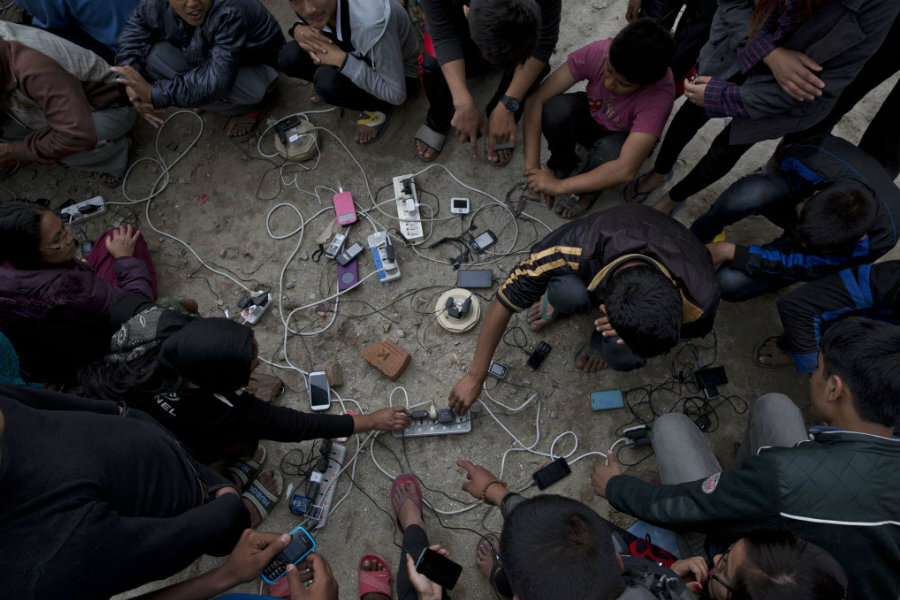In quake-prone Nepal, why solar power is an energy solution
Loading...
In its struggle towards recovery, quake-ravaged Nepal is turning to the heavens – literally.
Over the last few weeks, local solar companies have come together to deploy the sun’s energy to power homes, lights, and mobile-phone charging stations for relief workers and survivors across the country.
The effort is a testament to solar power’s growing significance in times of disaster. It also reflects the degree to which renewable sources are playing a key role in Nepal and other developing nations as they respond to the effects of climate change and carve a path towards energy and economic security.
“Developing countries are prioritizing solar, wind, and other renewable energy sources in order to reduce energy poverty, power economic progress, enhance national security by reducing imports, and protect the environment,” Phyllis Cuttino, director of Pew Charitable Trust’s clean energy initiative, said in a statement following the organization’s latest report on global energy investments.
From 2009 to 2013, renewable energy growth outpaced that of conventional technology in the top 10 emerging markets for clean energy, half of which are nations in East and Southeast Asia, the report found. Driving the movement is energy poverty, as the UN estimates that more than a billion people continue to lack access to modern electricity services.
The most attractive clean energy investment has been solar, according to the Pew report. The two devastating earthquakes that struck Nepal in April and May have served to highlight one reason why: In the face of climate change and natural disasters, dependence on hydroelectric power and fossil fuel imports poses a severe problem.
The 7.8-magnitude quake on April 25 affected at least 19 hydroelectric facilities in Nepal, knocking out more than 170 megawatts of power generation from the country’s grid, according to Gagan Thapa, chairman of Nepal’s Parliamentary Committee on Agriculture, Energy, and Natural Resources, and Kashish Das Shrestha, a writer who has worked with Mr. Thapa for a decade on sustainable development policy.
“[A] hydrocentric energy policy will continue to hold the nation hostage to inevitable seismic shocks,” they wrote in an op-ed for The New York Times.
The solution, they added, lies in diversification and distribution, with a focus on solar energy.
While solar lanterns have been a crucial part of global clean energy disaster relief since the Haiti earthquake in 2010, solar power’s full potential, both during a disaster and in the long term, has yet to be tapped in many countries.
In Nepal, some are hoping to change that. In the aftermath of the two quakes, Gham Power, a Kathmandu-based solar company, teamed up with the nonprofit Global Nepali Professional Network (GNPN) to raise funds to distribute solar power systems across the country, US magazine American Prospect reported.
Through crowdfunding site Indiegogo, the campaign, called “Rebuild with Sun,” raised almost $13,000 from individual donors, who gave $50, $100, or $500 for solar-power systems that would support one, three, or 15 families respectively. Another $100,000 came from corporate energy companies both local and global.
Despite its initial success, the program has yet to scratch the surface of Nepal’s electricity issues, according to Prospect. Even before the quakes, cities across the country were experiencing fuel shortages and power cutoffs for up to 16 hours a day.
“I hope that people will see that we're trying to … help with infrastructure that can help relief workers and Nepalis in this crisis and beyond,” Alyssa Newman, who is part of the Rebuild With Sun campaign, told American Prospect. “We also want to be a voice for clean energy in Nepal, and plan on connecting our immediate response to a longer-term solar rebuilding effort.”
Similar efforts are underway in other developing and disaster-prone nations such as the Philippines, where companies are investing significantly in solar power as the country’s solar capacity jumps from 50 megawatts in 2014 to an expected 500 by the end of 2015.
In Africa, small solar panels about the size of an iPad are letting families in rural Tanzania and Kenya – many of whom have long regarded lack of electricity as an inevitability of daily life – charge their phones, light their homes at night, and power basic necessities, fundamentally changing their lives.
“Climate change looms large for those of us working on energy and environmental issues,” Ms. Newman said, “and sometimes we need to all connect and work together to show how solar is a viable solution before and after disasters.”








